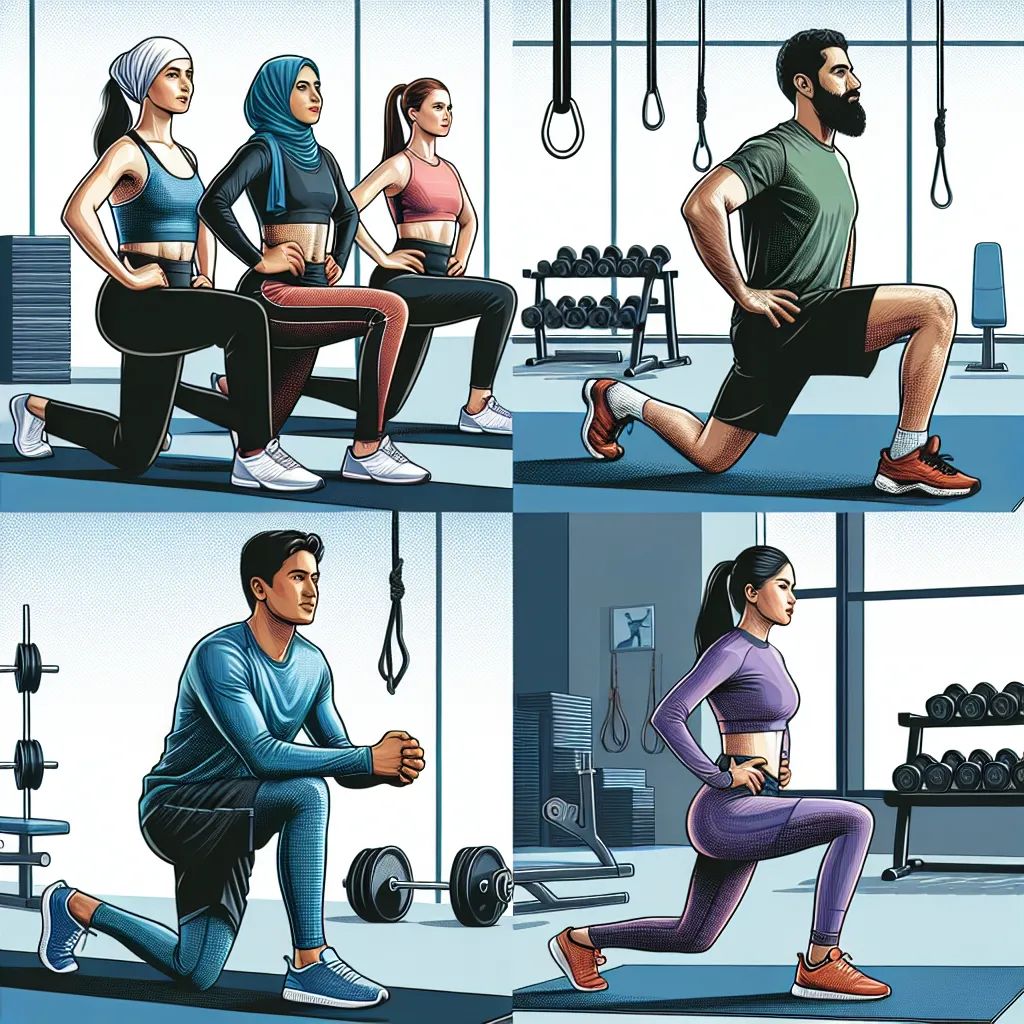Lunge variations are a crucial aspect of fitness training, but they can also serve as an excellent tool for expanding your English vocabulary, especially for the IELTS exam. Let’s dive into the world of lunge variations and explore how this fitness terminology can boost your language skills.
Definition and Pronunciation
Lunge variations /lʌndʒ væriˈeɪʃənz/ (noun phrase): Different types or modifications of the basic lunge exercise, designed to target specific muscle groups or increase the difficulty of the movement.

Context and Usage
Examples in Context
-
The personal trainer incorporated various lunge variations into the workout routine to challenge her clients’ balance and strength.
In this sentence, “lunge variations” refers to different types of lunges used in a fitness context to provide a diverse and challenging workout. -
Athletes often use lunge variations to improve their agility and lower body power for sports-specific movements.
Here, “lunge variations” emphasizes the versatility of the exercise in enhancing athletic performance across different sports. -
The physiotherapist recommended gentle lunge variations as part of the rehabilitation program for knee injuries.
This example shows how “lunge variations” can be adapted for therapeutic purposes, highlighting their role in medical contexts. -
In the IELTS Speaking test, the candidate expertly described various lunge variations when discussing fitness trends.
This sentence demonstrates how knowledge of specific fitness terminology like “lunge variations” can be beneficial in the IELTS exam. -
The fitness magazine featured an article on “10 Lunge Variations to Sculpt Your Lower Body,” showcasing the exercise’s popularity.
Here, “lunge variations” is used in a media context, indicating its relevance in health and fitness publications.
Common Contexts
Lunge variations are frequently discussed in fitness and sports-related contexts, including gym workouts, athletic training, physical therapy, and health magazines. In the IELTS exam, this term might appear in reading passages about health trends, sports science, or exercise physiology. It could also be useful in speaking and writing tasks when discussing personal fitness routines or general health topics.
Vocabulary Analysis
Word Structure
- Lunge (root word): A forward, downward movement
- Variations (suffix -ation added to ‘vary’): Different forms or versions
Synonyms and Antonyms
Synonyms:
- Lunge modifications /lʌndʒ ˌmɒdɪfɪˈkeɪʃənz/ (noun phrase): Changes or alterations to the basic lunge exercise
- Lunge adaptations /lʌndʒ ˌædæpˈteɪʃənz/ (noun phrase): Adjustments made to the lunge to suit different fitness levels or goals
- Lunge alternatives /lʌndʒ ɔːlˈtɜːnətɪvz/ (noun phrase): Different exercises that can be used instead of or in addition to traditional lunges
Antonyms:
- Standard lunges /ˈstændəd lʌndʒɪz/ (noun phrase): The basic, unmodified lunge exercise
- Fixed lunge routine /fɪkst lʌndʒ ruːˈtiːn/ (noun phrase): A lunge workout that does not include variations
Memory Techniques
Mind Mapping
Create a mind map with “Lunge Variations” at the center, branching out to different types (e.g., forward lunge, reverse lunge, side lunge), benefits (e.g., strength, balance, flexibility), and contexts (e.g., gym, sports, rehabilitation).
Storytelling
Imagine a fitness instructor named Lucy who loves “Lunge Variations.” Every day, she leads her class through a “Lovely Lunge Voyage,” where they “travel” to different countries by performing various lunge types. This story links the concept to travel and adventure, making it more memorable.
Practice Exercises
-
Writing Task: Describe your ideal fitness routine, incorporating at least three lunge variations. Use specific terminology and explain the benefits of each variation.
-
Speaking Practice: Imagine you’re a fitness instructor explaining lunge variations to a new client. Record yourself giving a one-minute explanation of different types and their benefits.
-
Reading Comprehension: Find a fitness article about lunge variations and summarize the main points, paying attention to specific terminology used.
-
Vocabulary Extension: Research and list five additional exercise variations (e.g., squat variations, push-up variations) and create sentences using each one.
-
IELTS-style Task: Write a 250-word essay on the importance of exercise variety in maintaining fitness motivation, using lunge variations as an example.
Conclusion
Mastering terminology like “lunge variations” not only enhances your fitness knowledge but also significantly boosts your IELTS vocabulary. By understanding its usage in various contexts and practicing with the exercises provided, you’ll be well-equipped to use this term confidently in your IELTS exam and in real-life situations.
Remember, expanding your vocabulary is like adding variations to your workout routine – it keeps your language skills dynamic and robust. Keep practicing, and don’t hesitate to incorporate these new terms into your daily English usage.
We’d love to hear about your experience learning and using “lunge variations” in your IELTS preparation. Share your thoughts or questions in the comments below!